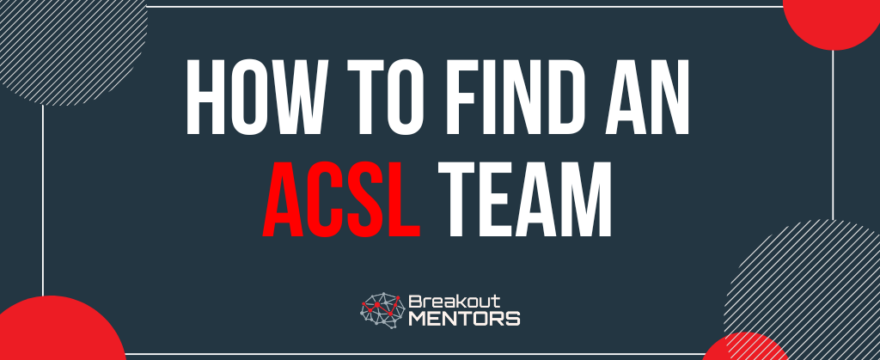I’m glad you decided to join the American Computer Science League (ACSL)! Thousands of similar kids and teenagers have used their competitions as a launching point to learn more computer science. The contests are excellent at providing motivation and showing learning mastery, while having fun.
For ACSL, one of the first steps is deciding whether to join an existing team or start a new one. In order to participate, you must have a team, which makes it more challenging to participate. The goal of this article is to show you how and make it as easy as possible for you to join the ACSL competition.
Here is your ACSL beginners guide on how to get started.
Navigating the Options for Participating in ACSL
If you don’t know much about it, please read ACSL Competition: A Comprehensive Breakdown of the Divisions and Practice Problems first. That will help you understand all the divisions and timelines.
For a lot more information about the event, I recommend watching this video linked from the ACSL homepage. The first 20 minutes are about the format of the contests and how it works with individual competitors on teams. The presentation is by Nathan Gorski, who has been running teams across the many ACSL divisions for many years.
The Format: Why You Need a Team and Can’t Compete on Your Own
ACSL contests are team events, but however, each competitor works individually. It is not a collaboration amongst the team. From their frequently asked questions page:
Can students collaborate?
Absolutely not. The ACSL tests must be completed individually. After students have completed the test, it’s a great idea to work together to go over the tests, to learn from each other’s mistakes, compare programming solutions, and to collaborate on the “most perfect” programming solution.
Then how do the teams work? Essentially, they take the top 3 or 5 scores from each team. However, forming teams allows for students to have peers to learn with and strive for improvement.
The Role of an Advisor in Shaping Champions
The team advisor plays a critical role in guiding a team through the ACSL contests. They provide support, resources, and motivation, helping students navigate the challenges of the competition and fostering an environment where young computer scientists can thrive.
One more important thing to consider about the advisor as well. They can provide a recommendation letter for your college or private high school applications. The advisor is well positioned to observe the effort your son or daughter puts into the extracurricular activity, which makes for a compelling voice in the eyes of admissions officers.
Joining an Existing Team
Students looking to participate in ACSL contests should first check if their school already has a team they can join.
Find Out if Your School Has a Team
Discovering if your school has an ACSL team involves checking with the computer science department or after-school clubs. Many schools participate in ACSL contests and are always looking for enthusiastic students to join their ranks.
Look for After-School Education Provider Teams
For students whose schools do not have an ACSL team, after-school education providers are a great option. There are dozens of private companies, both online and offline, that for teams to compete in ACSL each year.
However, it is important to note that students enrolled in full-time schools with ACSL teams can only compete on their school team. That means that even if they train and learn with a private tutor or class, they will not be able to compete with that group. Their score would count towards their school’s team instead.
Creating Your Own Team
Creating your own ACSL team can also be a great option for driven students. It gives you the opportunity to choose the group of students and advisor. You can also make sure the practice dates and format match your preferences as well.
Find More Students to Join Your Team
Finding students to join your ACSL team can be an exciting process. Start by reaching out to your classmates and friends at school who might be interested in coding. Consider making announcements during computer science classes or other relevant courses to spark interest.
Sports teams are another excellent place to look for potential team members. By diversifying your search across different groups, you can build a well-rounded team with various skills and perspectives.
Flyers and posters are a traditional yet effective way to spread the word about your team. Place them in high-traffic areas such as your community library or pool. These locations often have bulletin boards dedicated to student activities and events.
Don’t forget the power of social media. Create posts on platforms like Instagram, Twitter, and Facebook to invite students to join your team.
Secure a Team Advisor
Once you have a group of interested students, finding an advisor is your next step. Advisors can be teachers, older students, or professionals from your community. Reach out to teachers who might have an interest in computer science or mathematics, as they often have the expertise and enthusiasm to guide your team. Older students who have previously participated in ACSL or similar competitions can also be excellent advisors, offering peer mentorship and sharing their experiences.
Another option is to look for professionals or university students who are willing to volunteer their time. Many universities and tech companies encourage their students and employees to engage with the community, and they might be willing to support your team.
Essential Steps for Registering Your Team
Registering a new team requires submitting an application to ACSL, including details about your team members and advisor. Once approved, your team will be eligible to compete in ACSL contests. It’s important to note that ACSL encourages the formation of multiple teams from the same school or organization, offering more students the chance to participate.
Please note that the registration form is intended for team advisors, not students. Advisors can use this form to register teams and to purchase optional study materials.
Now, let’s move what you’ll need for the big day!
Mastering the Contest Day: How to Administer ACSL Contests
Administering ACSL contests involves setting up a suitable environment for your team to compete online. You should secure a quiet space with reliable internet access.
You should also be ready to help troubleshoot any issues that participants have. This could be computer or internet problems. Or misunderstandings about the contest rules.
The ACSL exam uses HackerRank as the platform to administer the test. Sometimes students have questions about how the interface works and how to submit their answers.
Joining ACSL is Worth the Effort
Joining the American Computer Science League (ACSL) offers a unique opportunity for students to dive deep into computer science. It challenges them to think critically and solve complex problems. The coding exercises are an engaging way to master coding fundamentals and push into more advanced material.
While the team-based nature of ACSL makes it harder to participate, there are benefits as well. Since you can only join ACSL as part of a team, you’ll interact with fellow coders during practice and after contests.
For those interested in independent practice, check out Liftoff Coders League for a variety of practice questions and weekly challenges that can help you sharpen your coding skills. And if you want a 1-on-1 mentor for competitive programming, our team is ready to help you advance so contact us today!




